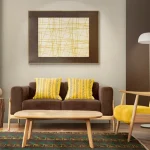Framing your artwork is like giving it a home—a place where it can truly shine. Whether you’re an artist, a collector, or just someone with a cherished print or painting, the right frame can take your art to the next level. Among the most popular frame sizes, the 11×14 painting frame strikes a beautiful balance between being substantial enough to catch the eye, yet still versatile and adaptable to various spaces. In this guide, we’ll walk you through the key considerations for selecting the perfect 11×14 frame for your art.
I’ve personally found that framing can completely change how a painting or photograph feels in a room. Once, I had a vibrant print of a landscape that I loved, but it looked too small and unimportant on my wall. When I finally invested in a simple yet elegant 11×14 frame with a wide mat, the picture suddenly became the focal point of the room. It was like magic! Here’s everything I’ve learned about framing along the way.
Why 11×14?
Choosing the right frame size starts with understanding why 11×14 is such a popular option. For one, it’s a practical size that complements many standard art prints and photographs. Whether you have a fine art painting, a family photo, or a modern print, an 11×14 frame provides ample space for your artwork without overwhelming your wall. It’s big enough to make a statement but small enough to fit seamlessly into most spaces, from living rooms to bedrooms or even offices.
The Versatility of 11×14 Frames
The 11×14 frame size works well for a variety of settings. If you want your artwork to have a more gallery-like appearance, you can add a wide mat inside the frame, making the piece look larger and more refined. This size is also ideal for creating a cohesive gallery wall, where multiple 11×14 frames can be arranged together for an eye-catching display.
As Nate Berkus, a well-known interior designer, says, “A frame is like a piece of jewelry for a piece of art” (nateberkus.com). And when you’re dealing with an 11×14 frame, it can act as that perfect accessory to elevate your piece.
Choosing the Right Style for Your 11×14 Frame
1. Frame Material: Wood, Metal, or Something Else?
The material of the frame can dramatically change the look and feel of your artwork. Wooden frames often add warmth and an organic quality, while metal frames tend to feel sleek and modern.
- Wooden Frames: These are classic and timeless. They bring a natural warmth to artwork and are perfect for traditional paintings, landscapes, and portraits.
- Metal Frames: For a contemporary or industrial look, metal frames are the way to go. Their clean lines make them a great match for abstract art or modern photography.
- Acrylic or Plastic Frames: These are lighter and often less expensive but can still offer a minimalist and modern look.
When I framed one of my watercolor pieces, I chose a natural wood frame, and it added a soft elegance to the painting. That said, for a bolder, more modern piece I have hanging in the living room, a black metal frame was the perfect choice to give it a sleek and minimalist edge.
As Martha Stewart wisely says, “A well-chosen frame can elevate a piece of art to a new level” (marthastewart.com).
2. Frame Color: Neutral or Bold?
The color of your frame can either blend into the background or make a bold statement. Neutral colors like black, white, and natural wood are popular choices for frames because they tend to work with almost any style of art.
- Black Frames: These are classic, and versatile, and work with nearly any piece of art, especially modern or abstract pieces.
- White Frames: A white frame offers a light, clean look and can make the colors in the artwork pop.
- Wood Tones: If you prefer a natural, earthy aesthetic, wood tones such as oak, walnut, or pine are perfect for adding warmth to your art.
If you’re feeling adventurous, you can go for bold-colored frames, such as metallics or vibrant hues, that can either complement or contrast with the colors in your artwork. Just make sure the color of the frame enhances your piece rather than overshadowing it.
3. Matting: To Mat or Not to Mat?
A mat is the border between your artwork and the frame itself, and it serves both functional and aesthetic purposes. A mat can help prevent the artwork from touching the glass, which protects it from moisture and damage. But more importantly, a mat can elevate the presentation of your art.
- Wide Mats: For an 11×14 frame, a wide mat can create a more gallery-style look, giving the artwork extra breathing room. A mat also draws attention to the art itself.
- Narrow Mats: If you want a less dramatic effect, a narrow mat can add a subtle touch of elegance.
Albert Hadley, a legendary interior designer, once said, “The frame is the dress of the picture” (architecturaldigest.com), and adding a mat is like adding an extra accessory to that outfit.
Expert Tips on Framing 11×14 Artwork
- Think About the Space: Where will the artwork hang? If it’s going in a small space like a hallway or bathroom, a more understated frame might work best. In larger rooms, you can go bolder with both the frame and the artwork itself.
- Consider the Style of the Artwork: Is the piece traditional or modern? Landscape or portrait? Jennifer Post, a seasoned art professional, notes, “A frame is a way to elevate a piece of art and make it a focal point in a room” (cfa.arizona.edu). Choose a frame style that enhances the art’s natural style and makes it stand out in the room.
- Don’t Be Afraid to Experiment: Sometimes, pairing a modern frame with a more traditional painting or a rustic frame with contemporary art can create an unexpected, yet delightful contrast.
The Psychology of Framing
Did you know that the way you frame your artwork can actually influence how people perceive it? According to a study titled “The Psychology of Framing: How Frames Influence Our Perception of Art,” frames do more than just hold your artwork in place—they shape our emotional response to the piece. By choosing a frame that complements the colors, themes, and style of the artwork, you can guide the viewer’s emotional experience.
In my own experience, I found this to be true when I reframed a family photograph. It had been in a plain, dull frame for years, and no one paid much attention to it. After I reframed it in a sleek, white 11×14 frame with a soft beige mat, it became a centerpiece on my gallery wall. The new frame completely transformed how people responded to the photo.
Conservation and Durability
Frames are not just decorative—they also play a crucial role in preserving your artwork. Michael Graves puts it well: “The frame is a way to give a piece of art a sense of place and time” (michaelgraves.com). If you’re framing an original painting or a valuable print, you’ll want to ensure that your frame protects it from potential damage.
1. UV-Protective Glass
If your artwork will be hanging in a room with lots of sunlight, consider UV-protective glass. This will help prevent fading over time, especially for watercolors or photographs.
2. Acid-Free Mats
If you’re using a mat, choose one that’s acid-free to prevent the paper or canvas from yellowing over time.
Displaying 11×14 Frames in Your Home
The 11×14 size is perfect for many different spaces. If you’re creating a gallery wall, consider mixing and matching different frames but keeping the color scheme consistent. This adds visual interest without feeling chaotic. In a more minimalistic room, a single 11×14 painting in a bold frame can serve as the focal point.
I once used an 11×14 frame to highlight a simple ink drawing I made while traveling. Though the drawing was small, the large mat inside the frame gave it a sense of importance and created balance on an otherwise empty wall in my office. Every time I see it, I’m reminded of that trip—and the frame enhances those emotions.
Final Thoughts
An 11×14 painting frame is not just a practical way to display your artwork—it’s an essential part of the art itself. It has the power to transform a piece, making it the centerpiece of a room or seamlessly integrating it into your home décor. As David Hockney wisely noted, “I think a frame is very important. It’s like a picture frame for a photograph; it gives it a context” (christies.com).
So, when you’re selecting a frame for your 11×14 artwork, think about the story you want it to tell, the mood you want to set, and how it will fit into your space. Whether you’re framing a cherished photo, a piece of art you created, or a print you bought on a whim, the right frame can elevate it from a simple image to a piece of art that truly shines.










